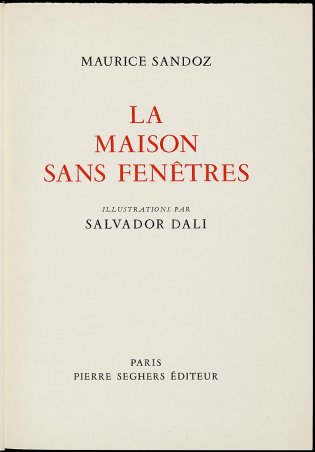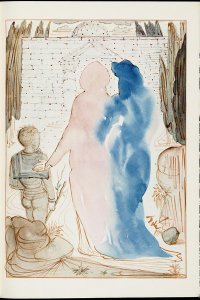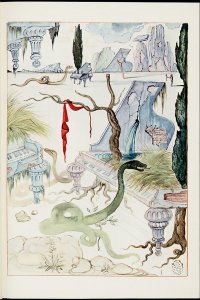La maison sans fenêtres
Year: 1949
Author: Maurice Sandoz (1892 - 1958)
Artist: Salvador Dalí (1904 - 1989)
Publisher: Pierre Seghers, éditeur
Bibliographical description
Description: La maison sans fenêtres / Maurice Sandoz ; ill. par Salvador Dalí. - Paris : Pierre Seghers, éditeur, 1949. - 116 p., [8] bl. pl. : ill. ; 27 cm
Printer: Union (Paris)
Edition: 2500 copies
This copy: Number 1660 of 2500 on Alfa-Marais
Bookbinder: Schrijen (Sittard)
Bibliography: Bénézit 4-195 ; Monod 10152
Shelfmark: KW Koopm A 109
References
- Paul van Capelleveen, Sophie Ham, Jordy Joubij, Voices and visions. The Koopman Collection and the Art of the French Book. The Hague, Koninklijke Bibliotheek, National Library of the Netherlands; Zwolle, Waanders, 2009
- Paul van Capelleveen, Sophie Ham, Jordy Joubij, Voix et visions. La Collection Koopman et l'Art du Livre français. La Haye, Koninklijke Bibliotheek, Bibliothèque nationale des Pays-Bas; Zwolle, Waanders, 2009
- Salvador Dalí, Mijn leven als genie. Gekozen, vertaald en ingeleid door Gerrit Komrij. Amsterdam/Antwerpen, Uitgeverij Atlas, 2004
- Jacques Gaucheron, 'Les collections Pierre Seghers', in: La pensée,(1950), 28 (jan), p. 104-108
- Gilles Néret, Salvador Dalí: 1904-1989. Köln, Taschen, 1999
- Max Lucien Scheler, 'Pierre Seghers', in: Europe, 66 (1988),705/706, p. 176-179


